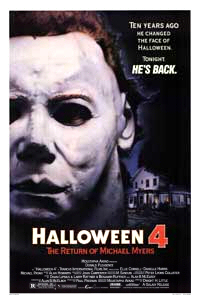
There have been more misses than hits in the pantheon of the Halloween franchise. I guess whenever you try to string along a series of movies based on only the most minimal of story, that’s bound to happen. Fortunately, when this indefatigable legacy churns out a good movie, then it’s really good.
Such is the case with Halloween 4: The Return of Michael Myers. Sure, it’s ain’t Chekov, but arguably, it stays in vein with the original Halloween, which is arguably the most accomplished of all slasher flicks. It’s brutal, yet restrained and even after almost 30 years, it remains a timeless and terrifying classic. But it’s not really the film to thank for The Return. That credit goes to Halloween 2, the first film to link Laurie Strode to Michael’s lineage. Although it was only meant to be a nifty little twist in the first sequel, come 8 films later, this thread bare concept has been used ad nauseum to link Michael to everything from the Druids to Josh Hartnett (now that’s scary!). The Return took a cue from Part 2 and took it one step further by giving a now seemingly deceased Laurie a daughter (Jamie Lee Curtis would come back for H20 and mysteriously she’d appear with a son instead). Jamie (Danielle Harris, whose character name is an obvious nod to Ms. Curtis), is a forlorn child dealing with the loss of her mother. She’s been taken in by the Carruthers family who are doing their best to make Jamie feel welcome. Well almost their best. Their teenage daughter, Rachel (Ellie Cornell) has kind of a love/hate relationship with the whole new family addition thing, especially when it gets in the way of her seeing her mancub Brady (Sasha Jenson) on Halloween because she has to take Jamie Trick or Treating. Although Jamie wants to be wanted, she becomes a bit more concerned about a man who’s been following her – a man she believes to be the boogeyman. By the time darkness sets on Haddonfield on all Hallows’ Eve, everyone will come to believe that Jamie is right.
Danielle Harris, who would grow up to be a very beautiful woman, is great in the role as Jamie. For a child actress to have endured what she did here and in the less stellar fifth entry and remain normal is quite a feat these days. For her thankless work in some not so good movies (she ruled the roost in the horrible Urban Legend), she was given a part in Rob Zombie’s highly anticipated remake of the original. She is definitely the high point of the Return but the ultra vixen-ish Kathleen Kinmont as Kelly Meeker adds just the right amount of bitch as Rachel’s arch nemesis. Kathleen’s part is played to perfection all the way to her T-shirt which proclaims “Cops Do It by the Book”. Kinmont also became a familiar and welcome face in latter part of the slasher cycle. Of course, no one comes close to Donald Pleasance’s consistently hysterical portrayal of Dr. Loomis. There are a few crazed scenes featuring the obsessive Loomis having kind of grand time. Check him out with the preacher (the late and very great Patrick Cranshaw).
One of the elements director Dwight Little took from the original is maintaining a claustrophobic atmosphere. The second half of The Return takes place mostly in Sheriff Meeker’s house (Beau Starr) and there are some nice suspenseful moments to be had. Also, the sub-plot about mob mentality might not have been fully realized, but it’s an interesting comment on how we as a society react when faced with something unknown or seemingly unstoppable. It’s a nice touch and it gives the town of Haddonfield a bit of extra personality.
The Return is nothing more or nothing less than a good slasher film. As straightforward as a ruler, this movie leaps happily from Point A to Point B without much concern for anything extraneous. By the time this movie had come out in 1988, simplicity in the genre had all but disappeared. The slasher cycle was drawing to a close and we were gearing up for the post-modern movement of self-aware horror. That kind of makes The Return a little bit of a time capsule. It’s one of the last films to capture the pure innocence of the sub-genre. Contrary to politically correct beliefs, movies that adhered strictly to the guidelines were not offensive at all. In fact, how can you not look back at that time and see a more unaffected era when an audience wasn’t so jaded that they had to keep one step ahead of a film. Even with such an exact formula, we allowed ourselves to get caught up in the chaos. And that’s a beautiful thing.
